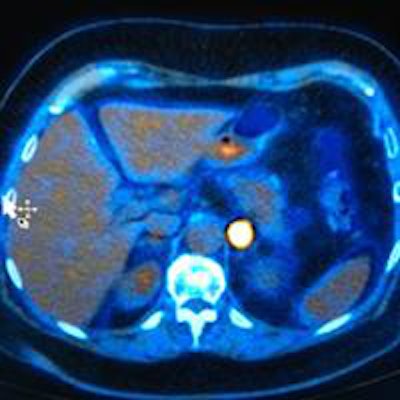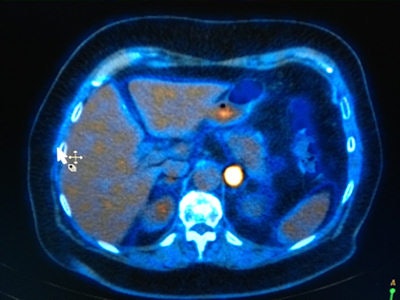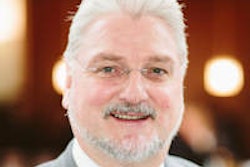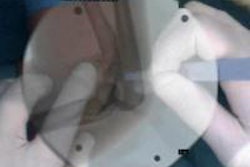
LONDON - Radiology must fully embrace new training pathways and translational research so that young doctors are capable of progressing research from the laboratory to the clinic, a senior radiologist noted in a broad-ranging, visionary, public lecture on Thursday evening.
Taking molecular imaging (MI) as an example, the majority of MI conducted in the U.K. is in nuclear medicine, said Dr. Richard Fowler, a consultant radiologist who recently retired from Leeds General Infirmary. "We train in nuclear medicine up to consultant level but we need to pay attention to the many other modalities emerging including functional MRI and MRI spectroscopy, functional CT and perfusion CT."
 A shift toward nuclear medicine technologies is occurring. This PET/CT image shows abnormal uptake of isotope in the left para-aortic region. Image courtesy of Dr. Richard Fowler.
A shift toward nuclear medicine technologies is occurring. This PET/CT image shows abnormal uptake of isotope in the left para-aortic region. Image courtesy of Dr. Richard Fowler.If trainees only get trained in one modality then they are missing out on the other areas, he explained in a keynote titled "Radiology 20/20 vision: Will science fiction become reality?" New training pathways are necessary for trainees to become research-competent, as well as enabling them to drive the research forward.
"I don't think employers have fully grasped the notion of the investment required for the future," he said. "But I can appreciate the challenge because they spend their time firefighting on every front to retain core services in the presence of ever-shrinking budgets. Investment in radiologists and the type of molecular imaging training needed is understandably not high on their agenda."
There is also an urgent need for greater "interdisciplinarity," particularly working more closely with mathematicians, according to Fowler. The vast amounts of data that will be associated with new imaging techniques and clinically emerging fields such as genomics will require people to collate and analyze the data. "We can't cope with the data levels now, let alone what is promised in the future."
Furthermore, with new imaging techniques, and to handle even today's vast reams of data, new computing power is needed desperately. "Current computers are soon going to reach their finite limit as individual transistors reach their physical limit. Enter quantum computers and biological computers," he said.
Despite facing significant difficulties with staff shortages and technological issues, the U.K. Royal College of Radiologists (RCR) will play a huge part in pushing forward MI science for the benefit of patients, he said. Future technology was exciting for clinician and patient, but a significant challenge lay in how that technology would be translated into practice and wide-scale patient benefit.
"The future is rosy once we get over a few hurdles on the way," he remarked. "The field will expand to molecular imaging but lose some aspects of current work which are not molecular-based." He cited breast screening as a typical example, whereby in 30-40 years time, this practice is most likely to become obsolete because diagnosis will be possible using a blood test.
Future technology
Fowler noted that since x-rays were developed, the vast majority of imaging has been structural and anatomical, but this has shifted to PET/CT and other nuclear medicine technologies. "In the future, this will expand to new techniques such as molecular imaging for targeting specific disease processes such as those involved in inflammatory diseases and cardiovascular diseases, as well as cancers that already use advanced imaging techniques."
In parallel, there will be new ways of dissecting out gene sequences, and it will be essential to become more specific with imaging diagnostics, he added. Currently, MI is mainly used in PET/CT for cancer diagnosis, providing excellent images from which to make a diagnosis and monitor response to treatment. In this era of personalized medicine, having decided that a patient has a subtype of disease, that subtype will be targeted by a variety of investigative agents and MI will evaluate which actually works, he explained.
 The future is rosy once we get over a few hurdles, according to Dr. Richard Fowler.
The future is rosy once we get over a few hurdles, according to Dr. Richard Fowler.
However, he cautioned that use of these advanced technologies would be limited if the workforce failed to develop sufficiently. "Ideally, radiology, with the appropriate workforce, has the opportunity to be central to the growth of personalized medicine, with ever more specific diagnoses."
In the U.K., there are only four radiologists per 100,000 people, compared with 10 per 100,000 in the U.S., and seven per 100,000 in Western Europe. Across all countries, the imaging load was comparable, according to Fowler.
"Firstly, we need increased numbers of trainee radiologists," he said, adding that the RCR had already managed to convince the Department of Health of the need for increased numbers of trainees to deliver more consultants, but there was a time lag of five to six years. "The numbers are favorable, but not enough to meet the demand for fully trained radiologists."
Unfortunately, the central positioning of radiology in healthcare was not recognized sufficiently by wider circles, plus there was pressure on employers to provide 50% of trainee funding, which did little to encourage progress, Fowler stated.
In response to the huge shortage of radiologists, the RCR had been lobbying for years for extra radiologists; a recent announcement of 30 new radiology places per year was progress, but actually a drop in the ocean compared with what was needed, remarked Dr. Giles Maskell, RCR president and consultant radiologist at the Royal Cornwall Hospital in Truro.
"More and more radiologists are needed due to the high end, complex imaging techniques which are starting to be used. In terms of molecular imaging, we have just added it into the curriculum for trainee radiologists, so they are learning more about cell biology," he said. "We've also got some funding to train a few people in the small number of centers that we have to develop expertise in this."



















